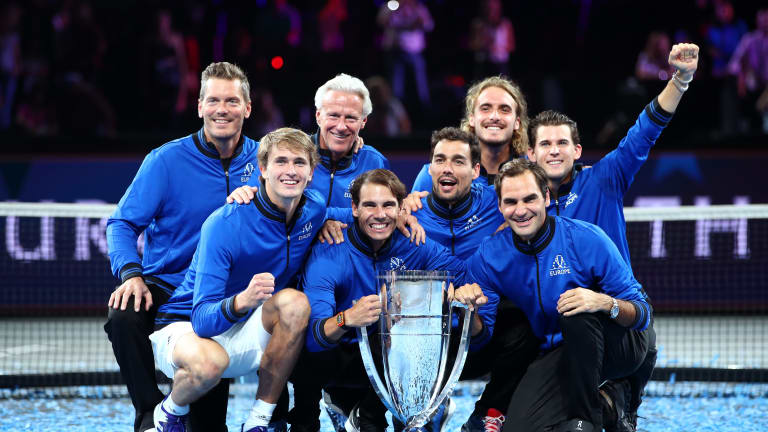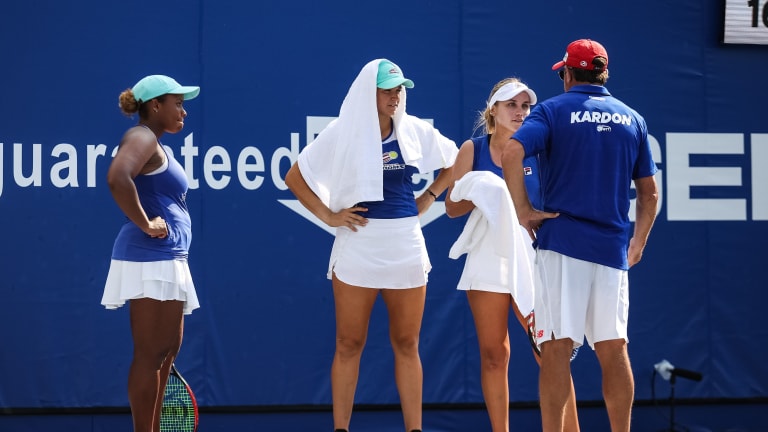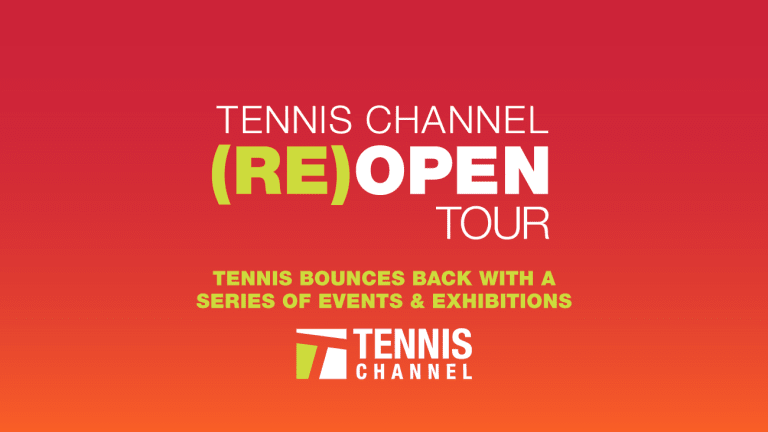The Rally: What the team craze can do for college and Olympic tennis
Jul 20, 2020Laver Cup
Rafael Nadal accepts Bjorn Borg's Laver Cup invitation to play for Team Europe in Berlin
By TENNIS.com Apr 22, 2024Social
Big 3 salutes their retiring 'friend' Joao Sousa in Estoril
By Baseline Staff Apr 07, 2024Social
Roger Federer to deliver commencement speech at Dartmouth College
By Ed McGrogan Mar 28, 2024Miami, USA
Top 5 Miami Finals, No. 1: Roger Federer d. Rafael Nadal, 2005
By Steve Tignor Mar 27, 2024Social
Coco Gauff wants to play as the Big Three after TopSpin 2K25 unveils full player roster
By Stephanie Livaudais Mar 23, 2024Lifestyle
Roger Federer opens up on retirement to GQ: He doesn't miss pro tennis, but hitting a forehand is 'like riding a bike'
By Baseline Staff Mar 15, 2024Indian Wells, USA
Top 5 Indian Wells Finals, No. 4: Dominic Thiem d. Roger Federer, 2019
By Steve Tignor Mar 13, 2024Pop Culture
Carlos Alcaraz can’t wait to “play as myself” in upcoming TopSpin 2K25 tennis video game
By Stephanie Livaudais Mar 13, 2024Pop Culture
Roger Federer is California dreamin' as he takes in Golden State Warriors game, attends Oscars
By Baseline Staff Mar 10, 2024The Rally: What the team craze can do for college and Olympic tennis
Tennis can be every bit the team game that soccer or hockey or basketball are.
Published Jul 20, 2020
Advertising
In this week's edition of The Rally, Joel Drucker and Steve Tignor assess the current craze for team play, offer ideas for college and Olympic formats, and yearn for the return of a good old-fashioned tournament.
Hi Steve,
As an individual sport, tennis highly values self-reliance, independence and sheer individual effort.
But then there’s also this sober truth: Whenever studies are done that evaluate declines in the tennis business, it’s often noted that people frequently leave tennis because they can’t find playing partners. A major reason for this is the game’s ruthless competitive structure, an exclusionary hierarchy that happens at all ages and skill levels. There are parents who don’t want their children on the court with players they deem less skilled. Kids often duck one another too. Ditto for adults. Just ask men and women who join clubs and find it difficult to get into doubles games or even simply find hitting partners.
For several decades, the saving grace for this form of snobbery has been various forms of team tennis. In the U.S., nothing at the recreational level carries more communal clout than USTA League tennis. In theory, players sign up and—presto, they’re on a squad and have ample partners and opponents. In practice, as I’ll discuss shortly, it’s more complicated.
At the pro level, team events can be quite inspiring. Davis Cup, Fed Cup and, most recently, Laver Cup, have all had moments of engaging tennis and exceptional emotion. College tennis also has its share of compelling moments. I suspect one of the reasons players so enjoy these team events is that they are rare—sparkling departures from the rigors of solo competition.
And then there’s World TeamTennis (WTT), the co-ed, fast-paced league founded by Billie Jean King and her husband, Larry, way back during the lively tennis boom of the ‘70s.

The Rally: What the team craze can do for college and Olympic tennis
Advertising
World TeamTennis' Chicago Smash snap a team selfie. (Ryan Loco)
This year, due to the pandemic, the entire World TeamTennis is being played in a bubble—a rather elegant one, The Greenbrier, located in White Sulphur Springs, West Virginia.
It’s been fun watching the matches and seeing players get reacquainted with the demands of competition. Most of the time, tennis players can appear transcendent, glorious athletes armed with racquets, big-time skills and a global passport. But this year, they’ve been brought down to earth just like all of us. “You know what it’s been like the last four months,” Tennys Sandgren of the Orlando Storm said this week in a Washington Post article. “You’ve been sitting in your house the whole damn time. I get to do it in a beautiful setting now. It’s fantastic.”
Amid the profound isolation we’ve all been experiencing, the kindly, communal aspect of team play is also comforting—be it players cheering one another on, a coach offering a pointer, or even something as banal as seeing Kim Clijsters fetch a ball for a teammate. In the same way that saying hello to someone on a walk through my neighborhood or having a Zoom call with a friend is now strikingly powerful, so are those little social interactions that are a part of WTT. I’ll be curious to see how this plays out among recreational players once it’s possible for league tennis to return.
Steve, what strikes you about WTT this year? And how might that be similar or different from what you’ve noticed about it in other years?
Hi Joel,
Tennis people love the individual nature of the sport, but I don’t think I’d ever realized what a hindrance that can be to participation until I watched my nephews and niece make their sporting choices over the last decade. They’re all athletically inclined and all could have been strong tennis players, but the sport was never in the running, because their friends were on the soccer team, the lacrosse team, the hockey team. I guess tennis players are the peculiar ones, because we’re drawn away from groups and into solo spaces.
What’s really unfortunate is that, as you say above, tennis can be every bit the team game that soccer or hockey or basketball are. I’ve played on high school teams, college teams, USTA league teams, even a corporate league team for Tennis Magazine in New York (we beat Goldman Sachs for the title one year, hehe). You enjoy just as much camaraderie on a tennis team as you do on a basketball team. Yet tennis still clings to its myth of individualism. When I graduated from college, the idea of traveling to play tournaments by myself, and facing off against people I didn’t know, wasn’t appealing at all. Adult leagues, though, were fun.

The Rally: What the team craze can do for college and Olympic tennis
© Getty Images for Laver Cup
Advertising
Team Europe lifted the Laver Cup for the third straight year in 2019. (Getty Images)
Theoretically, the answer to all of tennis’s supposed problems at the pro level would be to turn it into a pure team sport as well. Instead of having Serena Williams play Wimbledon, she would play for a team from Los Angeles, and fans around the country would fill arenas for their local tennis teams the way they do their local baseball teams. That was the original idea for WTT, and in the booming days of the 1970s, it almost worked. But tennis couldn’t quite make the transition from a sport that’s based on watching individual stars to one that’s based on watching your city’s team. Chris Evert actually skipped the French Open to play WTT three times (she would have her own La Décima in Paris if she hadn’t), but when she dropped out of WTT at the end of the 70s, its momentum stalled.
Yet it does live on, and it seems to be thriving at the Greenbrier right now. These days WTT has been joined by a wave of new team events: Laver Cup, the ATP Cup, a revamped Davis Cup and Fed Cup, and an assorted group of team-style exhibitions during the lockdown. But one thing hasn’t changed: stars rule in tennis. The one undeniable success among the new team competitions has been Laver Cup, and that’s because it’s headlined by Roger Federer and Rafael Nadal. The exception to the star rule, of course, is Davis Cup, which has a 120-year tradition behind it to give it significance.
The odd one to me, Joel, is the ATP Cup. When it debuted this January, I fully expected to love seeing Djokovic, Nadal, Kyrgios, Medvedev and most of the ATP's big names play for their countries. In reality, I just ended up missing the tournaments that have traditionally opened the season Down Under.
These team events might end up making me appreciate how much I like old-fashioned, individual-versus-individual tennis tournaments. I could really go for a Masters 1000 right now myself.
How about you, Joel, would you like to see more team tennis, or less?
Team Peace defeated Team Kindness to capture the 2020 Credit One Bank Invitational:
Advertising
Steve,
What I’d like to see is high-level tennis take a more nuanced and innovative approach to team events.
Let’s start with the Olympics. While success has many parents, failure is an orphan. Who was driving the bus when the decision was made not to make the Olympic tennis event a team competition? I remain staggered. And why not change it even now?
First, let’s admit that the Olympic tennis event is more important as a global showcase for tennis than as a one-off competition akin to an ATP or WTA tournament. Second, let’s show off tennis’ most unique and compelling asset: men and women, competing together. Third, add in the patriotic dimension that the Olympics thrives on. Imagine, for example, if the Olympic gold medal came down to a mixed doubles event between the American team of Serena and John Isner versus the Swiss duo of Federer and Martina Hingis. Sizzling. Think of how much interest that would drive in tennis.
Next comes college tennis. NCAA administrators have spoken for years about the need to create events that are streamlined and easily viewable in-person, on-line, on phones, and on TV. Gone are the days of dual matches that last five or more hours. In this case, the WTT format would be a perfect fit—all five disciplines, a co-ed competition played on one court in approximately two hours. Surely, this would generate tons of energy on a college campus.
That said, there are aspects of team play in tennis I do not like. A Grand Slam champion once told me that she wished all of tennis was a team sport. I countered by saying, “You just say that because you’re convinced you’d always get to be the quarterback.” Team sports like baseball, football and basketball feature all sorts of role players—utility infielders, tackles, seventh men. But in tennis, the lure is the chance to be everything—quarterback, receiver, linebacker, safety, head coach and even team owner, sometimes even all on the same point. In tennis, you don’t need a captain to validate your right to compete. Just go play tournaments.
But team tennis events feature all sorts of shenanigans. I’ve heard, witnessed and been personally frustrated by numerous team play machinations. There are the politics of the line-up, the lobbying that takes place for various partners, the players who only play their match and leave, the sandbagging to keep ratings down. Most odious of all are the decisions about which people get to play. One unfortunate reality of league tennis is negative reinforcement for improving. Consider: a high-level 4.0 who can win frequently will likely get more chances to play in matches than an entry-level 4.5 who is just dipping his toes into this new skill level.
Tell me more about your team experiences, Steve. I’m particularly interested to hear if you think college tennis should deploy the WTT format.

The Rally: What the team craze can do for college and Olympic tennis
Advertising
The Philadelphia Freedoms at this year's edition of World TeamTennis. (Ryan Loco)
Joel,
I like your Olympic team idea, and also wonder why it has never been tried. I’ve enjoyed Olympic tennis since it returned in 1988, but what’s the advantage of making the event into basically another dual-gender Masters 1000, but without third-set tiebreakers?
I also like your WTT idea for college tennis, and can’t believe I had never thought of it before. When I was in school, every singles and doubles match was traditional best-of-three sets (though we did use no-ad scoring back then). In those days, we would have balked at the idea of playing anything less, but we also didn’t care how long the dual matches lasted, or how many people came to watch them. Times have obviously changed. Drawing fans to college tennis has become a goal, and matches have been shortened to six-game sets and eight-game pro sets to try to make the sport more watchable for fans and manageable for players.
So if you’re trying new things, why not try a WTT-style co-ed format, maybe as a way to open up the season, and see how it goes? Like you said, it seems perfect for creating an event-like atmosphere on campus. We’ve heard a lot of talk recently about unifying the tours; why not try to do it at other levels of the game as well?
As for USTA leagues, it’s amazing how good a 4.5 player can be, isn’t it? The problem is that there are a limited number of 5.0 teams to play on (let alone 5.5 or 6.0), so every decent player ends up jammed into the 4.5s and 4.0s. And like you said, if you win too many matches, you might get kicked up to a level where there are fewer teams and fewer opportunities to play. I’ve always wondered whether breaking the leagues up by age group (25-and-under, 35-and-under, 45-and-under, etc.) wouldn’t be a simpler system. It would solve the NTRP shenanigans, but probably create a whole new set of issues.
I started my first entry today talking about how hard it is to get kids to play tennis because they can’t join a team with their friends. Ideally, we would find a way to fix that, but the truth is, unlike soccer, basketball, or any other team sport, you play tennis by yourself and mostly for yourself. This summer, I’ve enjoyed seeing the sport in various experimental formats, from UTR to UTS to WTT to the Credit One Bank Invitational in Charleston. More than anything, though, they’ve made me appreciate I like the game just as it is.

The Rally: What the team craze can do for college and Olympic tennis